Cover
Half-title
Title
Copyright
Contents
Figures
Tables
Contributors
Editors/authors
Authors
Input providers
Preface
Introduction
Figures
Tables
Introduction
1 The case and the theoretical framework
1.1 Wi-Fi: an unexpected success story
1.2 The theoretical framework
1.3 Innovation and the landscape lens
1.4 Theory and empirics
1.5 Structure of the book
Notes
References
Part 1 The Wi-Fi Journey
2 NCR: taking the cue provided by the FCC
2.1 The innovation trigger: the FCC Report and Order
2.1.1 The process of telecommunication reform
2.1.2 The origin of spread spectrum
2.1.3 The governance of radio frequency spectrum
2.1.4 Early civil applications of spread spectrum
2.1.5 The link to mobile telephony
2.2 The NCR response to the FCC Report and Order
2.2.1 NCR: the company
2.2.2 The link to the Netherlands
2.3 The development of local area networks13
2.3.1 The creation of a LAN standard
2.4 NCR: providing the seed money for wireless LAN development
2.4.1 The WLAN feasibility study
2.5 Summary of theWi-Fi journey: 1980–1987
2.6 Interpretation of the Wi-Fi case in the context of theory
2.6.1 Innovation and the innovation landscape
2.6.2 Institutional environment and industry evolution
Notes
References
3 Creating a wireless LAN standard: IEEE 802.11
3.1 The start of wireless LAN product development
3.1.1 The role of standards within NCR
3.1.2 In search of an existing MAC protocol
3.1.3 Differences in making standards
3.1.4 Engaging with the IEEE
3.1.5 The rules of order in the IEEE
3.1.6 Robert’s Rules of Order
3.2 NCR involvement in IEEE 802.4: token bus
3.2.1 The need for a new MAC protocol
3.3 Standards work within the IEEE
3.3.1 Organisation of the standards work
3.4 The start of IEEE 802.11
3.4.1 NCR taking the lead
3.4.2 The need to explain opposition in voting
3.5 Competing proposals within IEEE 802.11
3.5.1 The first battleground: IBM versus NCR/Symbol Technologies/Xircom
3.5.2 The second battleground: frequency hopping versus direct sequence
3.5.3 The third battleground: HomeRF
3.5.4 The fourth battleground: HIPERLAN
3.5.5 The fifth battleground: Lucent Technologies versus Harris versus Micrilor
3.6 Formal approval of IEEE 802.11 standard
3.6.1 Approval of the first extensions: IEEE 802.11a and 11b
3.6.2 The ISO ratification of the standard
3.7 Reflections on the standardisation process in the IEEE
3.7.1 Reflections on participation
3.7.2 Reflecting on the standard-making process
3.8 Summary of theWi-Fi journey: 1987–1999
3.9 Interpretation of theWi-Fi case in the context of theory
3.9.1 Firm strategy and standard-making
3.9.2 The strategic considerations in standard making
3.9.3 Institutional environment and industry evolution
3.10 The evolving world of ICT standard setting
3.10.1 The notion of ‘open standards’
3.10.2 Relations between stakeholders
3.10.3 Coordination and competition in standardisation
3.10.4 The role of the individual
3.10.5 The individual in the case of IEEE 802.11
3.11 Innovation and the innovation landscape
Notes
References
4 Crossing the chasm: the Apple AirPort
4.1 Crossing the chasm
4.2 The early market
4.2.1 The product launch
4.2.2 The sales channel
4.2.3 Security concerns
4.2.4 Getting the product market combination right
4.2.5 The market outside the United States
4.2.6 Global versus local products
4.2.7 Carnegie Mellon University project ‘Wireless Andrew’
Structure of Wireless Andrew
Design challenges
Design procedure
Design tool
4.2.8 The competition on speed in LANs
4.3 The chasm
4.3.1 Increasing the data rate: the turbo version
4.4 The bowling alley
4.4.1 The Apple AirPort
4.4.2 Microsoft XP
4.5 Inside the tornado
4.5.1 The home market
4.5.2 Wireless Ethernet Compatibility Alliance
4.5.3 Resolving security issues
4.6 The penultimate success: Centrino
4.7 Summary of theWi-Fi journey: 1987–2003
4.8 Interpretation of the Wi-Fi case in the context of theory
4.8.1 Innovation and the innovation landscape
4.8.2 The institutional environment
4.8.3 The industry evolution
Notes
References
5 Hotspots: the Starbucks initiative
5.1 Introduction: Starbucks
5.2 Creating a hotspot business
5.2.1 The Swisscom case
5.2.2 Hotspot statistics
5.3 Hotspot business models
5.3.1 Value proposition
5.3.2 FON
5.3.3 Premium hotspots
5.3.4 Revenue model
5.3.5 Value network of actors: aggregators and clearing houses
5.3.6 Technological aspects
5.3.7 Convergence of Wi-Fi and cellular services
5.4 Summary of the Wi-Fi journey: 1993–2008
5.5 Interpretation of the Wi-Fi case in the context of theory
5.5.1 Innovation and the innovation landscape
5.5.2 Institutional environment
5.5.3 Industry evolution
Notes
References
6 Wi-Fi-based community networks: Wireless Leiden Wireless Leiden
6.1 Wireless neighbourhood area networks
6.2 The case of Wireless Leiden
6.2.1 The technical challenges
6.2.2 The organisation
6.2.3 Operating within the law
6.2.4 The competition
6.2.5 The reasons for success
6.2.6 Future direction
6.3 Municipal networks
6.4 Summary of theWi-Fi journey: WNANs, 2001–2007
6.5 Interpretation of theWi-Fi case in the context of theory
6.5.1 Institutional environment and industry evolution
Notes
References
Part 2 The Wi-Fi Journey in Perspective
7 Wi-Fi in developing countries: catalyst for network extension and telecom reform
7.1 Introduction
7.2 The challenge of universal access
7.2.1 The traditional model for implementing universal access subsidies
7.2.2 Direct subsidy funds
7.2.3 Universal access and local participation
7.3 Universal access in the information age
7.3.1 Internet economy and information society development
7.3.2 Towards universal access to information infrastructure
7.4 Towards universal access in developing countries
7.4.1 Cellular mobile for voice services
7.4.2 Towards internet and broadband access
7.5 The Wi-Fi opportunity
7.5.1 Assessing technology options
7.5.2 Wi-Fi characteristics
7.6 Wi-Fi: early experience
7.6.1 DjurslandS.net, Denmark
7.6.2 Nepal Wireless Networking Project
7.6.3 Dharamsala Community Wireless Network, India
7.6.4 Merida,´ Venezuela
7.6.5 Knysna network, South Africa
7.6.6 Mpumalanga network, South Africa
7.7 Sharing the Wi-Fi field experience
7.8 The role of policy and regulation
7.8.1 Indonesia: Wi-Fi practice reforming telecom policy17
7.9 Conclusion
Notes
References
8 The Dutch connection to US-based NCR, AT&T, Lucent Technologies and Agere Systems
8.1 Introduction
8.2 Context: the Dutch national innovation system
8.2.1 The model of political economy and the role of the state
8.2.2 From industrial policy to innovation policy
8.2.3 The WBSO Act
8.3 Structure and governance of the sector
8.3.1 From closed to open innovation in the sector
8.3.2 Early applications of RF technology in the Netherlands
8.4 The actor level: knowledge interactions
8.4.1 The NCR Systems Engineering Centre and its knowledge network
8.4.2 NCR/AT&T/Lucent Technologies: being part of a
8.4.3 Philips and Co.
8.4.4 Knowledge flow: Philips to NCR
8.5 University to industry linkages: the Eindhoven, Delft and
8.5.1 No Wires Needed: jumping on the bandwagon
8.5.2 MIMO: multiple data flows
8.6 Competing technologies and knowledge networks
8.6.1 Bluetooth: the need for ad hoc connectivity
The birth of a new technology
From idea to market
8.6.2 ZigBee: ultra short range
8.7 Other salient RF activities
8.8 Conclusions
Notes
References
9 Wi-Fi as community-based innovation
9.1 Introduction
9.2 Theoretical framework and methodology
9.2.1 The innovative agency of users
9.2.2 The innovative agency of communities
9.2.3 Methodology
9.3 The rise of Wireless Leiden as a user innovation
9.3.1 The shaping of Wi-Fi as indoor local area technology
9.3.2 Reshaping Wi-Fi as outdoor longer-distance technology
9.3.3 Reshaping Wi-Fi as a wide area network
9.3.4 User-initiated innovation as a collective activity of re-engineering
9.4 The growth of Wireless Leiden as a community-driven innovation
9.4.1 Aligning new actors, shaping heterogeneous user roles
9.4.2 The organisational user as sponsor
9.4.3 The volunteer-user
9.4.4 The residential end user
9.4.5 The maintenance user
9.5 The Wireless Leiden community as a sociotechnical network
9.6 Understanding Wireless Leiden as ‘community innovation’
Notes
References
10 The governance of radio spectrum: licence-exempt devices
10.1 Introduction
10.2 The theoretical framing of ‘common use’
10.3 Historical development in the use of radio spectrum
10.4 The radio spectrum governance paradigm
10.5 Radio spectrum governance in the United States: unlicensed devices
10.5.1 Part 15 devices
10.5.2 Part 18 devices
10.5.3 The 1985 landmark decision by the FCC: WLANs
10.5.4 Obtaining additional spectrum: PCS
10.5.5 Transition to 2.45 GHz in the United States
10.6 Radio spectrum governance in Europe
10.6.1 Involvement of the European Commission
10.6.2 Europe allocating the 2.45 GHz band: WLANs
10.7 Unlicensed devices outside the United States and Europe
10.7.1 Unlicensed devices in China: WLANs
10.7.2 Unlicensed devices in Japan: WLANs
10.7.3 Unlicensed devices in South Korea: WLANs
10.7.4 Unlicensed devices in other countries: WLANs
10.8 Towards a global allocation of the 5 GHz band for WLANs
10.8.1 Europe allocating the 5 GHz band: HIPERLANs
10.8.2 The United States allocating the 5 GHz band
10.9 The public–private coordination of RF spectrum use
10.10 The role of the ITU with respect to short-range devices
10.11 Frequency agile devices and dynamic spectrum access
10.11.1 Towards dynamic spectrum access
10.11.2 Implications of dynamic spectrum access for spectrum governance
10.11.3 Adapting the international regulatory framework
10.11.4 Adapting national regulatory frameworks
10.11.5 Dynamic spectrum access in an open access regime
10.11.6 Dynamic spectrum access in a market-based approach
10.11.7 First dynamic spectrum access applications
10.11.8 Conclusions
Notes
References
11 Exploring the future of Wi-Fi
11.1 Introduction
11.2 Appraising the current Wi-Fi trend
11.2.1 Wi-Fi: an undeniable success story – likely to continue
11.3 Converging with forecasts: technological innovation models as clues?
11.3.1 Models, approaches, theories and schools
11.3.2 Technologies as guidelines: the deterministic approaches
11.3.3 Technologies as social constructions
11.3.4 The case for a middle-of-the-road epistemological space in the interplay between technologies and society
11.3.5 Market views on modelling implications
11.3.6 Conclusion: preparing for more difficult tasks
11.4 A futures study approach to emerging wireless technologies24
11.4.1 Initial methodological choices
11.4.2 An initial set of questions and then two rounds of interactions
11.4.3 An intermediate synthesis
11.4.4 Scenarios
11.4.5 A need for narrowing down complexity and evaluating options
11.5 Generating utility from our findings
11.5.1 How do we evaluate scenarios?
11.5.2 Beyond 2015: the longer term
11.5.3 Around 2015
11.5.4 The short term
11.6 Conclusion: quite an open situation
Notes
References
12 Reflections and implications for policy
12.1 Summary
12.2 Reflecting on innovation
12.3 Reflecting on the standardisation process
12.4 Reflecting on radio spectrum management
12.5 Implications for government policy
12.6 Implications for firm strategy
12.7 Concluding remarks
Notes
References
Part 3 Annexes
Annex 1: Glossary
Annex 2: Timeline of major events related to Wi-Fi
References
Annex 3: Overview of IEEE 802.11 wireless LAN standards
Annex 4: The Wi-Fi ecosystem
Wi-Fi chipsets and products
Wi-Fi hotspots
References
Index
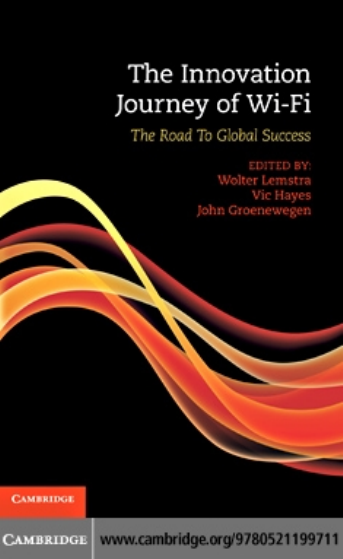

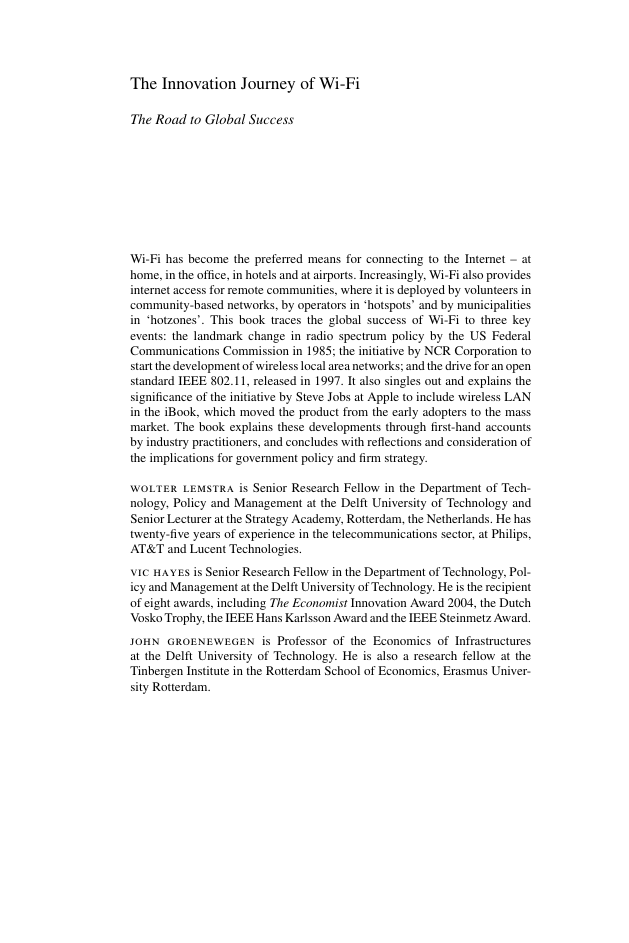

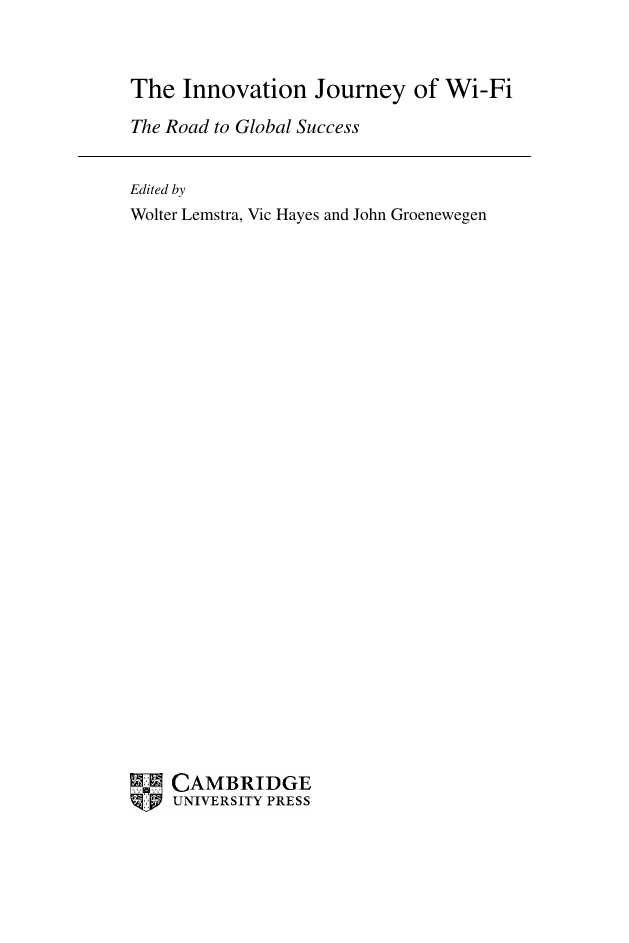
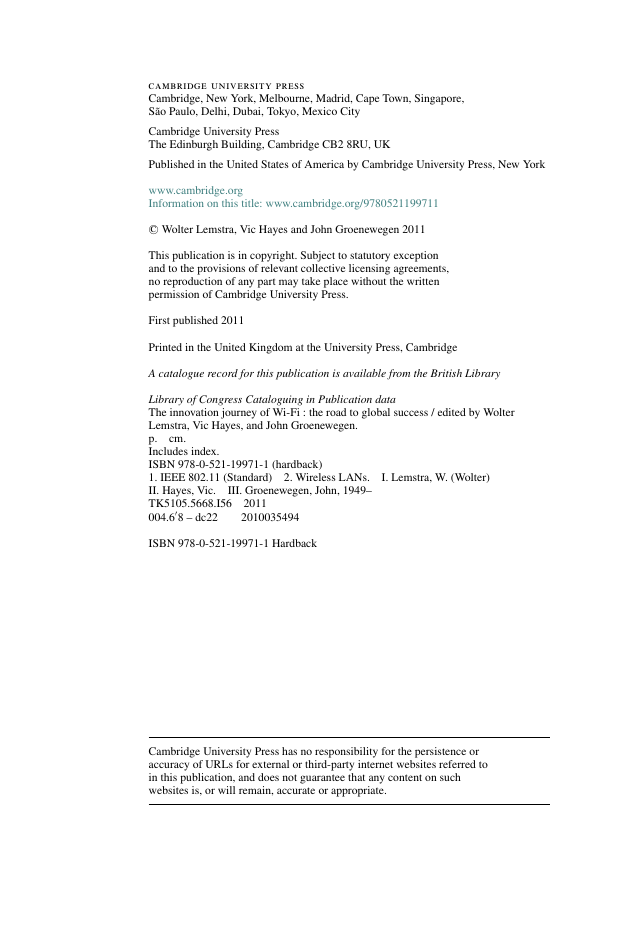

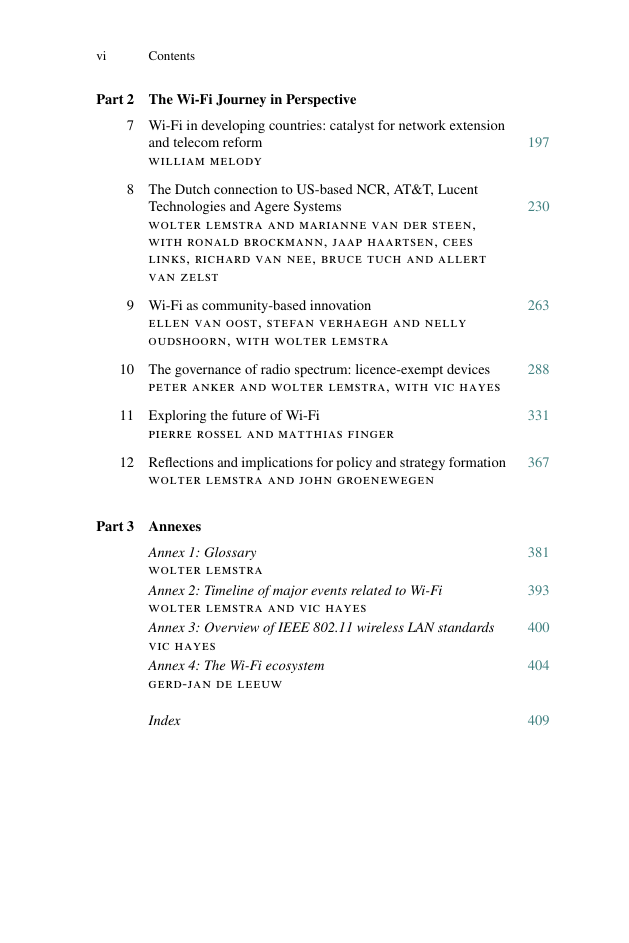








 2023年江西萍乡中考道德与法治真题及答案.doc
2023年江西萍乡中考道德与法治真题及答案.doc 2012年重庆南川中考生物真题及答案.doc
2012年重庆南川中考生物真题及答案.doc 2013年江西师范大学地理学综合及文艺理论基础考研真题.doc
2013年江西师范大学地理学综合及文艺理论基础考研真题.doc 2020年四川甘孜小升初语文真题及答案I卷.doc
2020年四川甘孜小升初语文真题及答案I卷.doc 2020年注册岩土工程师专业基础考试真题及答案.doc
2020年注册岩土工程师专业基础考试真题及答案.doc 2023-2024学年福建省厦门市九年级上学期数学月考试题及答案.doc
2023-2024学年福建省厦门市九年级上学期数学月考试题及答案.doc 2021-2022学年辽宁省沈阳市大东区九年级上学期语文期末试题及答案.doc
2021-2022学年辽宁省沈阳市大东区九年级上学期语文期末试题及答案.doc 2022-2023学年北京东城区初三第一学期物理期末试卷及答案.doc
2022-2023学年北京东城区初三第一学期物理期末试卷及答案.doc 2018上半年江西教师资格初中地理学科知识与教学能力真题及答案.doc
2018上半年江西教师资格初中地理学科知识与教学能力真题及答案.doc 2012年河北国家公务员申论考试真题及答案-省级.doc
2012年河北国家公务员申论考试真题及答案-省级.doc 2020-2021学年江苏省扬州市江都区邵樊片九年级上学期数学第一次质量检测试题及答案.doc
2020-2021学年江苏省扬州市江都区邵樊片九年级上学期数学第一次质量检测试题及答案.doc 2022下半年黑龙江教师资格证中学综合素质真题及答案.doc
2022下半年黑龙江教师资格证中学综合素质真题及答案.doc